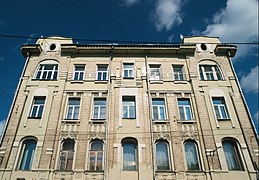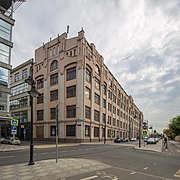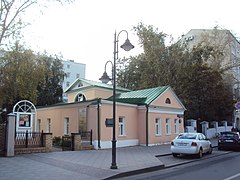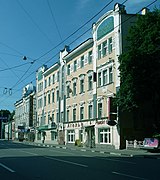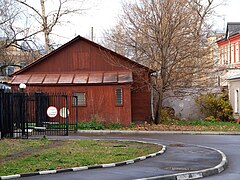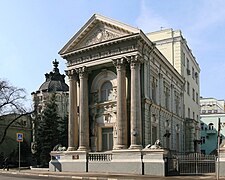Pyatnitskaya Street
The Pyatnitskaya Street ( Russian Пятницкая улица Pyatnitskaya Ulitsa ) is a street in the historic district Zamoskvorechye in the Central Administrative District of Moscow. It leads from the cast iron bridge of the water diversion canal to Serpukhovskaya Square. The length is 1.815 kilometers.
history
In the 14th century, when the area of today's Samoskvorechye district was still uninhabited, there was a trade route from the Kremlin to the southern cities of Ryasan , Tula and Serpukhov . In the 15th century a market called Leniwi torg (Lazy Trade) was established here, as business was carried out directly from the wagons. The section of the way to the market was therefore first called Leniwaja ulitza (Lazy Street). In the 16th century a wooden church was built here for the preacher Paraskeva Pyatnitsa , which burned down on May 9, 1564. At that time the street was called Pyatnitskaya . In the middle of the 17th century a new stone church was built and demolished in 1739 in favor of a third church building. This church was closed to religious services under Soviet rule (the priest Alexander Saozyorsky was shot in 1922) and demolished in 1935. At the end of the 17th century, the first stone residential building for the merchant Pyotr Zamyatin was built in the street with the Palaty Samjatina . In 1787 there was a major fire that affected the streets of Pyatnitskaya and Ordynka. Another fire in 1812 destroyed other wooden buildings. After that, the increasing construction of stone buildings began. Leo Tolstoy lived on Pyatnitskaya between 1854 and 1855. The historical architectural ensemble of Pyatnitskaya Street with its buildings from the 18th to the beginning of the 20th century has been well preserved, so that some of the buildings are recognized as state cultural objects of particular importance.
description
On the side with the odd house numbers are among others:
- No. 13/2 . A two-story house of the merchant Zamyatin from the 17th century, which was built over in the 19th century.
- No. 17. Residential building. 1903-1908. The architect was Sergei Suvorov
- No. 33. T. Korobkow's house from 1866. In the years from 1894 to 1899, it was built over by the well-known architects Lev Kekuschew and Sergei Shutzman. The first owner was the businessman Trifon Korobkow. The geologist Alexander Petrovich Karpinski lived here from 1935 to 1936, and the botanist and geographer Vladimir Leontjewitsch Komarow from 1936 to 1945 . The Tanzanian embassy was located here from the late 1950s to 2013 .
- No. 51. Trinity Church in Veshnyaki . Was built in the 17th century. The current building was constructed between 1804 and the 1830s.
- No. 53/18 residential building. 1914–1915, architect was Fyodor Ganeschin. Rebuilt in 1940.
- No. 59/19 Nine- story residential building for the Geodesija company . Was built 1934–1938 in the style of socialist classicism by the architect Kirill Afanasjew . It is the tallest residential building on Pyatnitskaya.
- No. 65. Residential building from 1910 (architect was Sergei Goncharov)
- No. 71/5 The Sytin printing house. Was built in 1903. The architect was Adolf Erichson , the engineer Wladimir Schuchow
On the side with the even house numbers are among other things:
- No. 12 The building is now part of the Tolstoy Museum. It was built in 1798 for the merchant Wargin. Lev Nikolayevich Tolstoy lived here with his brother Nikolai and sister Maria from 1854 to 1855.
- No. 54 residential building (1912–1914, architect was Semjon Surkow)
- No. 64 Rekk house. It was built in 1897 for Wilhelmina Rekk, the wife of the businessman Jakow Rekk. The architect was Sergei Scherwud. Today it belongs to the Ministry of Energy.
Buildings no longer preserved
- The Church of Paraskeva Pyatnitsa 1739, the bell tower from 1746 to 1748. The church was an important architectural dominant of the Samoskvorechye district. The building was demolished in 1935 and the Novokussnetzkaya metro station pavilion was built in its place in 1943.
- The building of the Institute for Theoretical Geophysics (since 1938) was built in the 1850s, rebuilt in 1893 and used as a women's school until the October Revolution . It was located between buildings 48 and 52 and was destroyed by German air raids in 1941.


